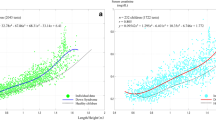Abstract
Assess creatinine levels in French children with Down syndrome (DS) on the basis of the relationship between creatinine levels and age. The study included 279 children with DS aged 0 to 10 years who had been regularly monitored between 2004 and 2021 in a single genetics department and who had had at least one creatinine measurement. The creatinine level curves were established by estimating the median and the quantiles of order 2.5 and 97.5% according to age. A Generalized Additive Model for Location, Scale, and Shape was used. The results showed higher creatinine levels in children with DS than in children from the general population.
Conclusion: The present results allow to propose an original chart of creatinine levels according to age in French children with DS, which should help optimize their medical management and improve the early detection of renal diseases.
What is Known: • Creatinine is a product of muscle breakdown and depends on muscle mass and children with Down syndrome have muscle and growth characteristics that differ from those of the general paediatric population. • Serum creatinine values in Japanese children with DS are higher than those of children from the general Japanese population. | |
What is New: • Creatinine values in French children with DS are higher than those of children from the general French population. • The proposed original chart for creatinine values according to age, specifically designed for individuals up to 10 years old, should serve for further investigation, prevention, and follow-up of children with DS. |

Similar content being viewed by others
Data Availability
The data used for the analysis can be provided upon reasonable request by any qualified investigator.
References
Levin J, Hasan A, Alba Alejandre I, Lorenzi I, Mall V, Rohrer TR (2023) Diseases Affecting Middle-Aged and Elderly Individuals With Trisomy 21. Dtsch Arztebl Int 120:14–24. https://doi.org/10.3238/arztebl.m2022.0371
Ranchin B, Bidault V, Zekre F et al (2023) Kidney and urological involvement in Down syndrome: frequent, underestimated, but associated with impaired quality of life and risk of kidney failure. Pediatr Nephrol. https://doi.org/10.1007/s00467-023-05986-y
González-Agüero A, Ara I, Moreno LA, Vicente-Rodríguez G, Casajús JA (2011) Fat and lean masses in youths with Down syndrome: gender differences. Res Dev Disabil 32:1685–1693. https://doi.org/10.1016/j.ridd.2011.02.023
Bertapelli F, Martín JC, Gonçalves EM, De Oliveira Barbeta VJ, Guerra-Júnior G (2013) Growth curves in Down syndrome: Implications for clinical practice. Am J Med Genet 164:844–847. https://doi.org/10.1002/ajmg.a.36337
Nishino T, Endo S, Miyano H et al (2021) Reference serum creatinine levels according to sex, age, and height in children with Down syndrome. Eur J Pediatr 180:2977–2983. https://doi.org/10.1007/s00431-021-04078-z
Ceriotti F, Boyd J, Klein G, Henny J, Queralto JM, Kairisto V, Panteghini M (2008) Reference Intervals for Serum Creatinine Concentrations: Assessment of Available Data for Global Application. Clin Chem 54:559–566. https://doi.org/10.1373/clinchem.2007.099648
Rigby RA, Stasinopoulos DM (2005) Generalized additive models for location, scale and shape (with discussion). Appl Stat 54:507–554. https://doi.org/10.1111/j.1467-9876.2005.00510.x
Cole TJ, Green PJ (1992) Smoothing reference centile curves: The lms method and penalized likelihood. Stat Med 11:1305–1319. https://doi.org/10.1002/sim.4780111005
Mariño-Ramírez L, Sharma S, Rishishwar L, Conley AB, Nagar SD, Jordan IK (2022) Effects of genetic ancestry and socioeconomic deprivation on ethnic differences in serum creatinine. Gene 837:146709. https://doi.org/10.1016/j.gene.2022.146709
Yamakawa S, Nagai T, Uemura O (2018) Down syndrome and mild kidney dysfunction. Pediatr Int 60:391–393. https://doi.org/10.1111/ped.13525
Nishino T, Endo S, Miyano H, Umeda C, Tomii Y, Watanabe Y, Nakagawa M, Kakegawa D, Fujinaga S (2021) Is the estimated glomerular filtration rate formula useful for evaluating the renal function of Down syndrome? Pediatr Int 63(8):944–950. https://doi.org/10.1111/ped.14539
Málaga S, Pardo R, Málaga I, Orejas G, Fernández-Toral J (2005) Renal involvement in Down syndrome. Pediatr Nephrol 20:614–617. https://doi.org/10.1007/s00467-005-1825-9
Postolache L, Parsa A, Simoni P, Boitsios G, Ismaili K, Schurmans T, Monier A, Casimir G, Albert A, Parsa CF (2022) Widespread kidney anomalies in children with Down syndrome. Pediatr Nephrol 37(10):2361–2368. https://doi.org/10.1007/s00467-022-05455-y
Savory DJ (1990) Reference Ranges for Serum Creatinine in Infants, Children and Adolescents. Ann Clin Biochem 27:99–101. https://doi.org/10.1177/000456329002700201
Acknowledgements
We are grateful to the families for participating in the study. We thank the Hospices Civils de Lyon for the funding of this study.
Funding
Hospices Civils de Lyon , crédit d’intéressement.
Author information
Authors and Affiliations
Contributions
All authors contributed to the study conception and design. Data collection was made by D.S. and S.G. The statistical analysis was performed by J.P. and M.R. The first draft of the manuscript was written by J.P. and all authors commented on it. All authors read and approved the content and submission of the final manuscript.
Corresponding author
Ethics declarations
Ethical approval
The study was approved by the local ethics committee IRB (Comité Scientifique et éthique des Hospices Civils de Lyon, number: 22_926) and by the national data protection agency (Commission nationale de l’informatique et des liberté, CNIL) in accordance with the reference methodology MR004 (number: 22_5926). This study was performed in line with the principles of the Declaration of Helsinki.
Consent to participate
All individual participants included in the study agreed to the use of their data for research and publication purposes.
Competing interests
The authors have no relevant financial or non-financial interests to disclose.
Additional information
Communicated by Gregorio Milani
Publisher's Note
Springer Nature remains neutral with regard to jurisdictional claims in published maps and institutional affiliations.
Rights and permissions
Springer Nature or its licensor (e.g. a society or other partner) holds exclusive rights to this article under a publishing agreement with the author(s) or other rightsholder(s); author self-archiving of the accepted manuscript version of this article is solely governed by the terms of such publishing agreement and applicable law.
About this article
Cite this article
Pautonnier, J., Goutte, S., Dubourg, L.D. et al. Creatinine levels in French children with Down syndrome up to ten years old. Eur J Pediatr 183, 1953–1957 (2024). https://doi.org/10.1007/s00431-024-05460-3
Received:
Revised:
Accepted:
Published:
Issue Date:
DOI: https://doi.org/10.1007/s00431-024-05460-3




